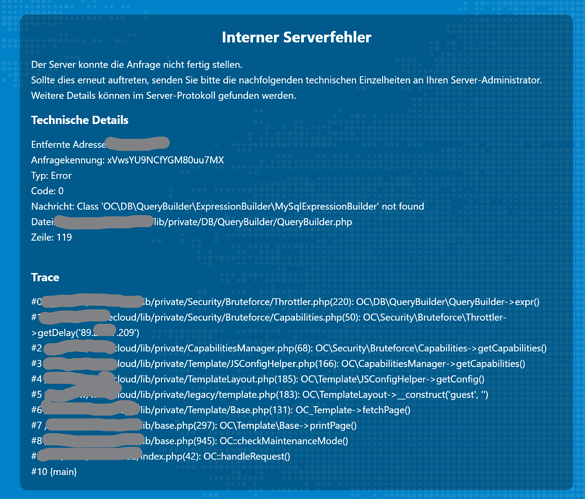Support intro
Sorry to hear you’re facing problems 
help.nextcloud.com is for home/non-enterprise users. If you’re running a business, paid support can be accessed via portal.nextcloud.com where we can ensure your business keeps running smoothly.
In order to help you as quickly as possible, before clicking Create Topic please provide as much of the below as you can. Feel free to use a pastebin service for logs, otherwise either indent short log examples with four spaces:
example
Or for longer, use three backticks above and below the code snippet:
longer
example
here
Some or all of the below information will be requested if it isn’t supplied; for fastest response please provide as much as you can 
Nextcloud version (eg, 12.0.2): 17.0.5.
Operating system and version (eg, Ubuntu 17.04): Ubuntu 18.04.4 LTS
Apache or nginx version (eg, Apache 2.4.25): 2.4.29
PHP version (eg, 7.1): 7.2.24
The issue you are facing:
I’m hosting Nextcloud on a virtual server. Until yesterday it ran on a Ubuntu 16.04. Server, but for (not further discussed) reasons i had to move my Nextcloud server to the clean and freshly installed Server specified above.
Using the Nextcloud Backup and Restore documentation, i made a backup of my Nextcloud-Folder and Database and moved it to the “new” server.
After installing all the required packages and php-extensions the Nextcloud server displays an internal server error with the following error message:
Thank you very much for your help in advance!
Is this the first time you’ve seen this error? (Y/N): Y
Steps to replicate it:
- ?
The output of your Nextcloud log in Admin > Logging:
PASTE HERE
The output of your config.php file in /path/to/nextcloud (make sure you remove any identifiable information!):
<?php
$CONFIG = array (
'instanceid' => 'MYID',
'passwordsalt' => 'MYPASSWORDSALT',
'secret' => 'MYSECRET',
'trusted_domains' =>
array (
0 => 'cloud.example.com',
1 => 'c.example.com',
),
'datadirectory' => '/var/www/MYCLOUD/data',
'dbtype' => 'mysql',
'version' => '17.0.5.0',
'dbname' => 'DBNAME',
'dbhost' => 'localhost',
'dbport' => '',
'dbtableprefix' => 'oc_',
'dbuser' => 'DBUSER',
'dbpassword' => 'DBPASSWORD',
'logtimezone' => 'UTC',
'installed' => true,
'maintenance' => true,
'theme' => '',
'logfile' => 'nextcloud.log',
'loglevel' => 'All',
'debug' => true,
'data-fingerprint' => 'DATAFINGERPRINT',
'updater.release.channel' => 'stable',
'memcache.local' => '\\OC\\Memcache\\APCu',
'mail_from_address' => 'XYZ',
'mail_smtpmode' => 'smtp',
'mail_smtpauthtype' => 'LOGIN',
'mail_domain' => 'mail.example.com',
'ldapIgnoreNamingRules' => false,
'ldapProviderFactory' => '\\OCA\\User_LDAP\\LDAPProviderFactory',
'mysql.utf8mb4' => true,
'mail_smtpsecure' => 'ssl',
'mail_smtpauth' => 1,
'mail_smtphost' => 'smtp.example.com',
'mail_smtpport' => '465',
'mail_smtpname' => 'host@mail.example.com ',
'mail_smtppassword' => 'MYTOPSECRETPASSWORD',
'app_install_overwrite' =>
array (
0 => 'files_downloadactivity',
1 => 'admin_notifications',
),
'trashbin_retention_obligation' => 14,
'updater.secret' => 'UPDATERSECRET',
);
The output of your Apache/nginx/system log in /var/log/____:
(no relevant information displayed :/)

